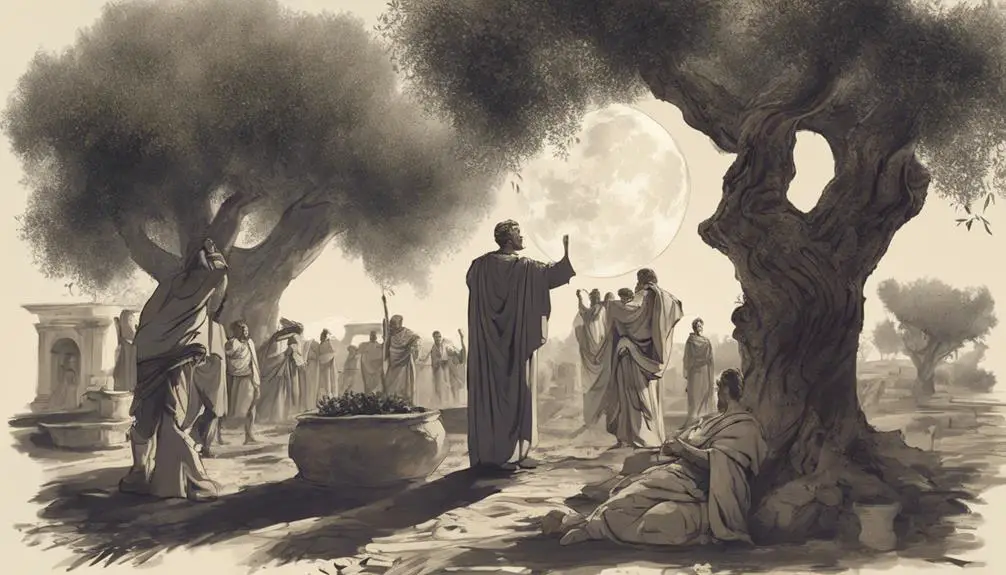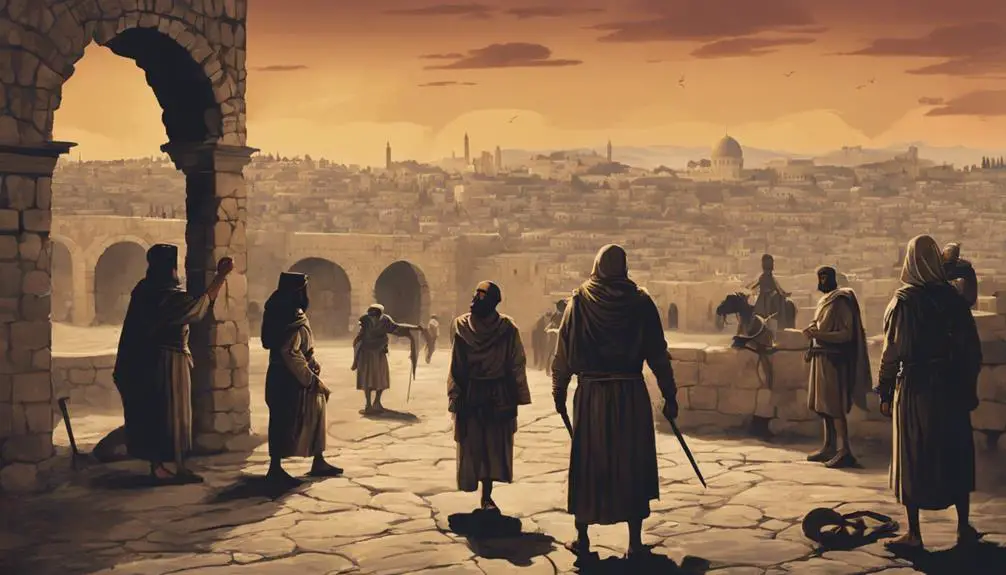Biblical figure Malchus becomes a symbol of compassion and miracle through an unexpected encounter with Jesus—discover his story's deeper significance.

Who Is Malchus in the Bible
Just as the moon's light reveals hidden secrets in the night, the story of Malchus sheds light on a unique moment in biblical history.
You might remember him as the servant who had an unexpected encounter with Jesus during a pivotal moment. Yet, his story is often overshadowed by the more prominent figures and events of the Bible.
You'll find that there's more to Malchus than meets the eye, especially when considering the significance of his ear being miraculously healed by Jesus. This act not only highlights the compassion of Jesus but also serves as a symbol that resonates through Christian tradition.
Let's uncover the layers of meaning behind this seemingly minor character and why his story matters.
Key Takeaways
- Malchus is known for having his ear cut off by Peter and then healed by Jesus.
- He symbolizes the intersection of religious, political, and divine forces in first-century Judea.
- The healing of his ear represents themes of mercy, restoration, and divine intervention.
- Malchus's encounter with Jesus underscores the message of compassion and reconciliation in Christian tradition.
The Historical Background

To understand Malchus's role in the Bible, it's crucial to delve into the historical context of first-century Judea, where religious and political tensions were at a peak. You're stepping into a period deeply entangled in Roman politics and Jewish customs, a time when the Roman Empire's dominance over Judea was marked by a complex blend of accommodation and resistance. This backdrop is key to comprehending not just Malchus's personal story but also the broader narrative of power and faith during this era.
Roman politics exerted a profound influence on the daily life and governance of Judea. The Romans installed puppet rulers and high priests, which often led to clashes with traditional Jewish customs and authority. These tensions weren't merely political; they were deeply intertwined with the religious beliefs and practices of the Jewish people. The Romans' insistence on the emperor's cult, juxtaposed with Jewish monotheism, created an environment ripe for conflict and dissent.
Understanding this, you see that Malchus, as a figure emerging from within this tumultuous context, symbolizes the intersection of these two dominant forces. His story is a prism through which the complexities of Judean society under Roman rule can be examined, revealing the intricate dance of power, faith, and identity in first-century Judea.
Malchus's Encounter With Jesus
Amid the turbulent events of first-century Judea, Malchus's encounter with Jesus stands out as a pivotal moment that illuminates the intersection of divine action and human affairs. This event, captured succinctly in the biblical narrative, reveals complex layers of human emotion and divine foreknowledge. To understand this encounter fully, consider the following points:
- Peter's Impulsivity: This incident is marked by Peter's rash action. His impulsive decision to draw his sword and strike Malchus, the high priest's servant, underscores a fundamental human tendency towards protective aggression in moments of crisis. Peter's impulsivity serves as a foil to Jesus' calm demeanor, highlighting the contrast between human instinct and divine serenity.
- Servant's Loyalty: Malchus, in his capacity as a servant, represents unwavering loyalty to his master. His presence in the arresting party, despite the imminent danger, underscores the deep-rooted sense of duty that characterized servants of the time.
- Divine Intervention: The encounter is a clear instance of divine intervention. Jesus' response to Peter's action and his interaction with Malchus showcase a moment of profound spiritual significance, transcending mere physical altercation.
- Human Affairs: This episode serves as a microcosm of the broader human condition, encapsulating themes of loyalty, duty, impulsivity, and divine intervention amidst the complexities of human affairs.
The Significance of Malchus's Ear

Building on the encounter between Jesus and Malchus, the injury and subsequent healing of Malchus's ear emerge as symbols rich in theological and narrative depth. This event isn't merely an anecdote; it's a confluence of ear symbolism and the power of healing miracles, offering layers of meaning to unravel.
Aspect |
Significance |
|---|---|
Ear Symbolism |
The ear often symbolizes openness, understanding, and the capacity to hear not just physically but spiritually. In the context of Malchus, this symbolism can represent a moment of divine intervention aimed at restoring not only physical wholeness but also spiritual receptivity. |
Healing Miracles |
Healing miracles in biblical narratives showcase divine mercy and power. Jesus's act of healing Malchus's ear is a testament to his compassion and a foretaste of the restoration he offers to humanity. |
Divine Intervention |
The miraculous healing serves as a divine intervention, signifying a moment of grace and calling attention to the higher purpose of Jesus's mission. |
Narrative Depth |
The incident adds a layer of narrative depth, intertwining human vulnerability with divine compassion, and highlighting the transformative power of empathy and forgiveness. |
This episode intricately weaves together themes of restoration, divine compassion, and the profound symbolism associated with the ear, thereby enriching our understanding of the biblical narrative.
Interpretations of the Event
Various interpretations of the healing of Malchus's ear by Jesus illuminate the multifaceted nature of this biblical event. Scholars and theologians have delved into its symbolic meanings and how it has been represented in artistic depictions, seeking a deeper understanding of its significance within the broader biblical narrative. Here are four key interpretations:
- A Display of Compassion: Some interpret the healing as a demonstration of Jesus's compassion, even towards those who opposed him. This act underscores his teachings on love and forgiveness.
- A Symbol of Restoration: The act of healing Malchus's ear is seen as symbolic of Jesus's broader mission to restore humanity to spiritual wholeness. It represents the reconciliation between God and humanity.
- A Sign of Divine Authority: By performing a miracle in the face of arrest, Jesus asserts his divine authority. This interpretation highlights his supernatural power and control over his own fate.
- Artistic Interpretations: In art, the event is often depicted to emphasize themes of mercy and the miraculous, reflecting the interpretations mentioned above. These artistic depictions serve as visual interpretations that enrich our understanding of the event's theological implications.
Analyzing these interpretations helps you appreciate the depth of this event, beyond its historical occurrence.
Malchus in Christian Tradition

In Christian tradition, Malchus occupies a unique position due to his direct encounter with Jesus, which showcases a profound moment of mercy and healing. This event, where Jesus heals Malchus's severed ear, offers a glimpse into the compassionate nature of Christ, even in the face of betrayal and violence. Malchus's lineage, though not extensively detailed in the scriptures, is significant as it connects him to the high priestly family, making this act of healing even more symbolic. It bridges the divide between Jesus and the Jewish authorities, emphasizing forgiveness and reconciliation.
Artistic depictions of this incident, spanning centuries, further illuminate Malchus's role in Christian tradition. These artworks often portray the moment with a focus on the themes of mercy and transformation. Through these visual narratives, Malchus serves as a testament to the power of Christ's compassion and the possibility of change, even for those who appear as adversaries. This narrative, richly woven into the fabric of Christian tradition, invites reflection on the nature of divine mercy and the capacity for healing and forgiveness, underscoring the inclusive and transformative message at the heart of the Christian faith.
Frequently Asked Questions
How Does Malchus's Story Differ in the Various Translations of the Bible?
You'll notice that Malchus's story varies across different Bible translations, highlighting translation discrepancies. These variations may affect the narrative's interpretation, especially concerning ear symbolism, which plays a significant role in this account.
While some translations might offer a more literal representation, others could provide a figurative or nuanced view. It's crucial to approach these differences analytically, recognizing how translation choices can alter our understanding of biblical events and symbols.
Are There Any Non-Biblical Historical Records That Mention Malchus or Corroborate His Encounter With Jesus?
Are you searching for concrete proof beyond ancient texts?
When it comes to archaeological evidence or historical records that might mention this figure or corroborate his unique encounter, you'll find the trail rather cold.
Despite thorough historical scrutiny, there's a notable absence of non-biblical accounts directly referencing him.
This gap challenges historians and scholars alike, pushing the boundaries of our understanding of historical accuracy in ancient narratives.
How Has Malchus Been Depicted in Religious Art Through the Centuries?
Throughout the centuries, artists have depicted Malchus with varying degrees of artistic interpretation, often focusing on symbolic representations of his encounter. These artworks serve as a visual exploration of themes like forgiveness and transformation.
Scholars analyze these pieces, noting how artistic liberties shape the portrayal of biblical narratives. This analysis reveals a rich tapestry of interpretations, each adding depth to our understanding of religious texts and their impact on culture and art.
What Psychological Implications Might Malchus Have Experienced After His Encounter With Jesus and the Miraculous Healing?
After your miraculous healing, you'd likely undergo trauma recovery, grappling with the shock and disbelief of the event. This experience could trigger a profound identity shift, forcing you to reassess your beliefs and allegiances.
The psychological ramifications would be complex, intertwining relief, confusion, and possibly guilt. You'd navigate a transformative journey, reevaluating your place in the world and the essence of your faith, potentially altering your life's trajectory.
How Do Different Christian Denominations View Malchus's Role and Significance Within the Context of Holy Week Events?
You're diving into a tapestry where colors blend—the ecumenical perspectives on Malchus's role during Holy Week.
Across the spectrum, denominational doctrines paint varied pictures, each thread embodying unique interpretations.
Analyzing these views, you'll find a scholarly, impartial exploration of his significance, from mere footnote to profound symbol.
This nuanced examination unearths how different Christian communities weave Malchus into their Holy Week narratives, reflecting a rich tapestry of belief and tradition.
Conclusion
In conclusion, Malchus's story, though a brief episode in the grand narrative of the Bible, serves as a poignant reminder that actions speak louder than words. Jesus' healing of Malchus's ear, amidst his own arrest, underscores a commitment to compassion over violence. This incident not only enriches our understanding of Jesus' teachings but also invites deeper reflection on the principles of forgiveness and nonviolence.
Analyzing Malchus's encounter offers valuable insights into the complexity of biblical narratives and their enduring relevance.



Sign up